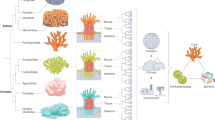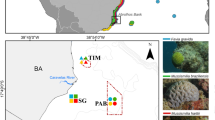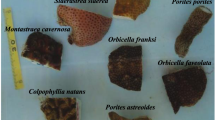Abstract
Coral reefs are deteriorating at an alarming rate mainly as a consequence of the emergence of coral diseases. The white plague disease (WPD) is the most prevalent coral disease in the southwestern Caribbean, affecting dozens of coral species. However, the identification of a single causal agent has proved problematic. This suggests more complex etiological scenarios involving alterations in the dynamic interaction between environmental factors, the coral immune system and the symbiotic microbial communities. Here we compare the microbiome of healthy and WPD-affected corals from the two reef-building species Diploria strigosa and Siderastrea siderea collected at the Tayrona National Park in the Caribbean of Colombia. Microbiomes were analyzed by combining culture-dependent methods and pyrosequencing of 16S ribosomal DNA (rDNA) V5-V6 hypervariable regions. A total of 20 410 classifiable 16S rDNA sequences reads were obtained including all samples. No significant differences in operational taxonomic unit diversity were found between healthy and affected tissues; however, a significant increase of Alphaproteobacteria and a concomitant decrease in the Beta- and Gammaproteobacteria was observed in WPD-affected corals of both species. Significant shifts were also observed in the orders Rhizobiales, Caulobacteriales, Burkholderiales, Rhodobacterales, Aleteromonadales and Xanthomonadales, although they were not consistent between the two coral species. These shifts in the microbiome structure of WPD-affected corals suggest a loss of community-mediated growth control mechanisms on bacterial populations specific for each holobiont system.
Similar content being viewed by others
Log in or create a free account to read this content
Gain free access to this article, as well as selected content from this journal and more on nature.com
or
Accession codes
References
Banin E, Israely T, Kushmaro A, Loya Y, Orr E, Rosenberg E . (2000). Penetration of the coral-bleaching bacterium Vibrio shiloi into Oculina patagonica. Appl Environ Microbiol 66: 3031–3036.
Barneah O, Ben-Dov E, Kramarsky-Winter E, Kushmaro A . (2007). Characterization of black band disease in Red Sea stony corals. Environ Microbiol 9: 1995–2006.
Ben-Haim Y, Thompson FL, Thompson CC, Cnockaert MC, Hoste B, Swings J et al. (2003). Vibrio coralliilyticus sp. nov., a temperature-dependent pathogen of the coral Pocillopora damicornis. Int J Syst Evol Microbiol 53: 309–315.
Bourne DG, Garren M, Work TM, Rosenberg E, Smith GW, Harvell CD . (2009). Microbial disease and the coral holobiont. Trends Microbiol 17: 554–562.
Chao A, Lee SM . (1992). Estimating the number of classes via sample coverage. J Am Stat Assoc 87: 210–217.
Denner EBM, Smith GW, Busse HJ, Schumann P, Narzt T, Polson SW et al. (2003). Aurantimonas coralicida gen. nov. sp. nov., the causative agent of white plague type II on Caribbean scleractinian corals. Int J Syst Evol Microbiol 53: 1115–1122.
Dustan P . (1977). Vitality of reef coral populations off Key Largo, Florida: recruitment and mortality. Environ Geol 2: 51–58.
Gaidos E, Rusch A, Ilardo M . (2011). Ribosomal tag pyrosequencing of DNA and RNA from benthic coral reef microbiota: community spatial structure, rare members and nitrogen-cycling guilds. Environ Microbiol 13: 1138–1152.
Gardner T, Côté J, Gill A, Grant A, Watkinson A . (2003). Long-term region-wide declines in Caribbean corals. Science 301: 958–960.
Garzón-Ferreira J, Gil-Agudelo DL, Barrios LM, Zea S . (2001). Stony coral diseases observed in southwestern Caribbean reefs. Bull Mar Sci 460: 65–69.
Gil-Agudelo D, Navas-Camacho R, Rodriguez-Ramirez A . (2009). Coral diseases and their research in colombian reefs. Bol Invemar 38: 189–224.
Gomez-Gil B, Thompson FL, Thompson CC, Swings J . (2003). Vibrio rotiferianus sp. nov., isolated from cultures of the rotifer Brachionus plicatilis. Int J Syst Evol Microbiol 53: 239–243.
Goreau TJ, Cervino J, Goreau M, Hayes R, Hayes M, Richardson L et al. (1998). Rapid spread of diseases in Caribbean coral reefs. Rev Biol Trop 46: 157–171.
Green EP, Bruckner AW . (2000). The significance of coral disease epizootiology for coral reef conservation. Biol Conserv 96: 347–361.
Harvell CD, Jordan-Dahlgren E, Merkel S, Rosenberg E, Raymundo L, Smith G et al. (2007). Coral disease, environmental drivers, and the balance between coral and microbial associates. Oceanography 20: 172–195.
Harvell CD, Kim K, Burkholder JM, Colwell RR, Epstein ER, Grimes E . (1999). Emerging marine diseases-climate links and anthropogenic factors. Science 285: 1505–1510.
Holt JG, Krieg NR, Sneath PHA, Stanley JT, Willims ST (eds) (1994). Bergey's Manual Of Determinative Bacteriology. Williams and Wilkins: Baltimore.
Hughes T, Baird H, Bellwood D, Card M, Connolly S, Folke C et al. (2003). Climate change, human impacts, and the resilience of coral reefs. Science 301: 929–933.
Jackson JBC . (2008). Ecological extintion and evolution in the brave new ocean. Proc Natl Acad Sci USA 105: 11458–11465.
Kimura M . (1980). A simple method for estimating evolutionary rates of base substitutions through comparative studies of nucleotide sequences. J Mol Evol 16: 111–120.
Kushmaro A, Banin E, Loya Y, Stackebrandt E, Rosenberg E . (2001). Vibrio shiloi sp. nov., the causative agent of bleaching of the coral Oculina patagonica. Int J Syst Evol Microbiol 51: 1383–1388.
Kvennefors EC, Sampayo E, Ridgway T, Barnes AC, Hoegh-Guldberg O . (2010). Bacterial communities of two ubiquitous Great Barrier Reef corals reveals both site- and species-specificity of common bacterial associates. PloS one 5: e10401.
Lane DJ . (1991). 16S/23S rRNA Sequencing. In: Stackebrandt E, Goodfellow M. (eds). Nucleic acid techniques in bacterial systematics. John Wiley & Sons: New York, 115–175.
Lesser MP, Thell JC, Gates RD, Johnstone RW, Hoegh-Guldberg O . (2007). Are infectious diseases really killing corals? Alternative interpretation of the experimental and ecological data. J Exp Mar Biol Ecol 346: 36–44.
Mulhall M . (2009). Saving the rainforests of the sea: an analysis of international efforts to conserve coral reefs. Duke Environ Law Policy Forum 19: 321–351.
Pandolfi JM, Bradbury RH, Sala E, Hughes TP, Bjorndal KA, Cooke RG et al. (2003). Global trajectories of the long-term decline of coral reef ecosystems. Science 301: 955–958.
Pandolfi JM, Jackson JBC . (2006). Ecological persistence interrupted in Caribbean coral reefs. Ecol Letters 9: 818–826.
Pantos O, Bythell JC . (2006). Bacterial community structure associated with white band disease in the elkhorn coral Acropora palmata determined using culture-independent 16S rRNA techniques. Dis Aquat Organ 69: 79–88.
Pantos O, Cooney RP, Le Tissier MD, Barer MR, O’Donnell AG, Bythell JC . (2003). The bacterial ecology of a plague-like disease affecting the Caribbean coral Montastrea annularis. Environ Microbiol 5: 370–382.
Patil PB, Zeng Y, Coursey T, Houston P, Miller I, Chen S . (2010). Isolation and characterization of a Nocardiopsis sp. from honeybee guts. FEMS Microbiol Lett 312: 110–118.
Patterson KL, Porter JW, Ritchie KB, Polson SW, Mueller E, Peters EC et al. (2002). The etiology of white pox, a lethal disease of the Caribbean elkhorn coral, Acropora palmata. Proc Natl Acad Sci USA 99: 8725–8730.
Pidiyar VJ, Jangid K, Patole MS, Shouche YS . (2004). Studies on cultured and uncultured microbiota of wild culex quinquefasciatus mosquito midgut based on 16s ribosomal RNA gene analysis. Am J Trop Med Hyg 70: 597–603.
Polson SW, Higgins J, Woodley C . (2008). PCR-based Assay for Detection of Four Coral Pathogens. Proc 11th Proc 9th Int Coral Reef Symp Ft Lauderdale 8: 247–251.
Reshef L, Koren O, Loya Y, Rosenberg I, Rosenberg E . (2006). The coral probiotic hypothesis. Environ Microbiol 8: 2068–2073.
Richardson LL . (1998). Coral diseases: what is really known? Trends Ecol Evol 13: 438–443.
Rohwer F, Breitbart M, Jara J, Azam F, Knowlton N . (2001). Diversity of bacterial associated with the caribbean coral Montastrea franksi. Coral Reef 20: 85–91.
Rosenberg E, Ben-Haim Y . (2002). Microbial diseases of corals and global warming. Environ Microbiol 4: 318–326.
Rosenberg E, Koren O, Reshef L, Efrony R, Zilber-Rosenberg I . (2007). The role of microorganisms in coral health, disease and evolution. Nat Rev Microbiol 5: 355–362.
Rosenberg E, Kushmaro A, Kramarsky-Winter E, Banin E, Yossi L . (2009). The role of microorganisms in coral bleaching. ISME J 3: 139–146.
Rosselló-Mora R, Amann R . (2001). The species concept for prokaryotes. FEMS Microbiol Rev 25: 39–67.
Rudolf I, Mendel J, Sikutova S, Svec P, Masarikova J, Novakova D et al. (2009). 16S rRNA gene-based identification of cultured bacterial flora from host-seeking Ixodes ricinus, Dermacentor reticulatus and Haemaphysalis concinna ticks, vectors of vertebrate pathogens. Folia microbiol 54: 419–428.
Saitou N, Nei M . (1987). The neighbor joining method: a new method for reconstructing phylogenetic trees. Mol Biol Evol 4: 406–425.
Santiago-Vazquez LZ, Bruck TB, Bruck WM, Duque-Alarcon AP, McCarthy PJ, Kerr RG . (2007). The diversity of the bacterial communities associated with the azooxanthellate hexacoral Cirrhipathes lutkeni. ISME J 1: 654–659.
Sato Y, Willis BL, Bourne DG . (2010). Successional changes in bacterial communities during the development of black band disease on the reef coral, Montipora hispida. ISME J 4: 203–214.
Schloss PD, Handelsman J . (2005). Introducing DOTUR, a computer program for defining operational taxonomic units and estimating species richness. Appl Environ Microbiol 71: 1501–1506.
Sekar R, Mills DK, Remily ER, Voss JD, Richardson LL . (2006). Microbial communities in the surface mucopolysaccharide layer and the black band microbial mat of black band-diseased Siderastrea siderea. Appl Environ Microbiol 72: 5963–5973.
Shannon CE . (1948). A mathematical theory of communication. Bell Syst Tech J 27: 379–432.
Spor A, Koren O, Ley R . (2011). Unravelling the effects of the environment and host genotype on the gut microbiome. Nat Rev Microbiol 9: 279–290.
Stackebrandt E, Goebel BM . (1994). A place for DNA–DNA reassociation and 16S rRNA sequence analysis in the present species definition in bacteriology. Int J Syst Bacteriol 44: 846–849.
Stecher B, Chaffron S, Käppeli R, Hapfelmeier S, Freedrich S, Weber TH et al. (2010). Like will to like: abundances of closely related species can predict susceptibility to intestinal colonization by pathogenic and commensal bacteria. PLoS Pathog 6: e1000711.
Sunagawa S, DeSantis TZ, Piceno YM, Brodie EL, DeSalvo MK, Voolstra CR et al. (2009). Bacterial diversity and white plague disease-associated community changes in the Caribbean coral Montastraea faveolata. ISME J 3: 512–521.
Sutherland KP, Porter JW, Torres C . (2004). Disease and immunity in Caribbean and Indo-Pacific zooxanthellate corals. Mar Ecol Prog Ser 266: 273–302.
Tamura K, Dudley J, Nei M, Kumar S . (2007). MEGA4: molecular evolutionary genetics analysis (MEGA) software version 4.0. Mol Biol Evol 24: 1596–1599.
Thompson FL, Barash Y, Swabe T, Sharon G, Swings J . (2006). Thalassomonas loyana sp. Nov., a causative agent of the white plague-like disease of corals on the Eilat coral reef. Int J Syst Evol Microbiol 56: 365–368.
Thompson JD, Higgins DG, Gibson TJ . (1994). CLUSTAL W: improving the sensitivity of progressive multiple sequence alignment through sequence weighting, position-specific gap penalties and weight matrix choice. Nucleic Acids Res 22: 4673–4680.
Wang Q, Garrity GM, Tiedje JM, Cole JR . (2007). Naïve bayesian classifier for rapid assignment of rRNA sequences into the new bacterial taxonomy. Appl Environ Microbiol 73: 5261–5267.
Waters VJ, Gomez MI, Soong G, Amin S, Ernst RK, Prince A . (2007). Immunostimulatory properties of the emerging pathogen Stenotrophomonas maltophilia. Infect Immun 75: 1698–1703.
Weil E, Smith G, Gil D . (2006). Status and progress in coral reef disease research. Dis Aquat Org 69: 1–7.
Weil E, Urreiztieta I, Garzón-Ferreira J . (2002). Geographic variability in the incidence of coral and octocoral diseases in the wider Caribbean. Proc 9th Int Coral Reef Symp Bali 2: 1231–1237.
Wilkinson CR . (1999). Global and local threats to coral reef functioning and existence: review and predictions. Mar Freshwater Res 50: 867–878.
Wolf A, Fritze A, Hagemann M, Berg G . (2002). Stenotrophomonas rhizophila sp. nov., a novel plant-associated bacterium with antifungal properties. Int J Syst Evol Microbiol 52: 1937–1944.
Youssef N, Sheik CS, Krumholz LR, Najar FZ, Roe BA, Elshahed MS . (2009). Comparison of species richness estimates obtained using nearly complete fragments and simulated pyrosequencing-generated fragments in 16S rRNA gene-based environmental surveys. Appl Environ Microbiol 75: 5227–5236.
Acknowledgements
We thank the personnel from the Institute of Genetics of the National University of Colombia for technical support, GeBiX center for computing platform, and Dr Liliana López for help in the statistical analysis. We also thank three anonymous reviewers for their comments and suggestions. This work was supported by grants from the Research Division (DIB), Universidad Nacional de Colombia to CAF and LFC.
Author information
Authors and Affiliations
Corresponding author
Rights and permissions
About this article
Cite this article
Cárdenas, A., Rodriguez-R, L., Pizarro, V. et al. Shifts in bacterial communities of two caribbean reef-building coral species affected by white plague disease. ISME J 6, 502–512 (2012). https://doi.org/10.1038/ismej.2011.123
Received:
Revised:
Accepted:
Published:
Issue date:
DOI: https://doi.org/10.1038/ismej.2011.123
Keywords
This article is cited by
-
Microbiome changes in Sinularia spp. soft corals relative to health status
Marine Biology (2024)
-
Aerial transport of bacteria by dust plumes in the Eastern Mediterranean revealed by complementary rRNA/rRNA-gene sequencing
Communications Earth & Environment (2023)
-
Microbial dysbiosis reflects disease resistance in diverse coral species
Communications Biology (2021)
-
Mussismilia braziliensis White Plague Disease Is Characterized by an Affected Coral Immune System and Dysbiosis
Microbial Ecology (2021)
-
Similar bacterial communities on healthy and injured skin of black tip reef sharks
Animal Microbiome (2019)



